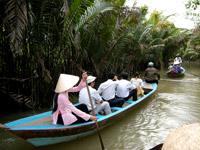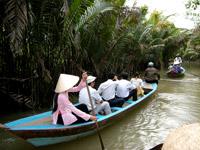Developing orchard tours in Mekong Delta

With a favorable location, an interlacing river system, a variety of delicious fruits and rich indigenous culture, the Mekong Delta has many advantages to develop orchard tours. But, orchard tour development is still unproportional with the potential due to a number of planning problems.
With 269,000 hectares of fruit, the Mekong Delta is the largest fruit growing area in Vietnam, which accounts for 70 percent of the country’s total fruit area. With a diverse range of fruits, which have high economic value such as Lo Ren Vinh Kim star apple, Hoa Loc mango, Cho Gao dragon fruit, Tan Phuoc longan and Cai Be mandarin and attractive tourist sites such as Thoi Son Island, Cai Be floating market…, the Mekong Delta has a lot of advantages to develop tourism. At a Vietnam Fruit Festival which recently took place in Tien Giang province, managers, scientists and businesses discussed weaknesses and suggested solutions to develop the region’s tourism.
According to associate professor, Dr. Luu Thanh Duc Hai, the deputy head of the Economics and Business Administration Department of the Can Tho University, Mekong Delta’s tourism should not only rely on available advantages. The delta needs to invest in infrastructure and technological development, strengthen human resources, diversify its range of tourist offerings, improve service quality, promote advertising and expand the market. In addition, it is necessary to focus on environmental protection based on inter-regional and interdisciplinary cooperation.
In reality, the Mekong Delta has not fully taken its available advantages. Nguyen Ngoc Minh, the director of the Tien Giang Province Department of Culture, Sports and Tourism, said that the biggest difficulty is the lack of an overall plan for orchard development that pertains to eco-tour development. Especially, the region does not pay proper attention to transport infrastructure system, including roads to orchards. Therefore, it is necessary to have inter-regional cooperation to overcome difficulties and utilize the advantages.
According to Dr. Tran Van Ngoi, the director of the management board of the Mekong Tourism Development Project, the region’s tourism development is still unproportional with the potential. A matter of concern is cooperation among provinces to establish brands for tourist offerings and create development breakthroughs. In addition, it is necessary for the Mekong Delta to invest in infrastructure and human resources and improve tourism services towards professionalism. Unqualified tourism staff and tourist sites, which are facing with the risk of degradation, are creating a lot of obstacles to tourist attraction.
Recently, the Ministry of Culture, Sports and Tourism approved the Mekong Delta Tourism Development Project to 2020. According to the project, investment capital in tourism from 2010-2015 is estimated at US$959.6 million, while US$963.7 million being demanded for the 2015-2020 period. The region is striving to attract 7.7 million tourists (including 2.7 million foreign visitors) by 2015 and 10.4 million (including 3.9 million of foreign visitors) by 2020 and create 236,600 jobs for local people. To reach the target, it is important to issue proper development policies and avoid inconsistent investment.










